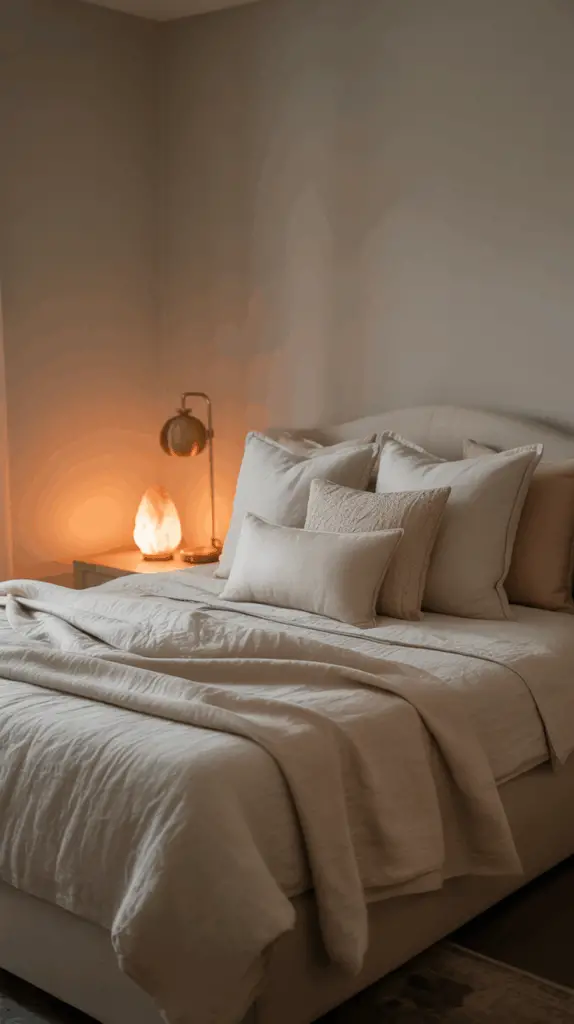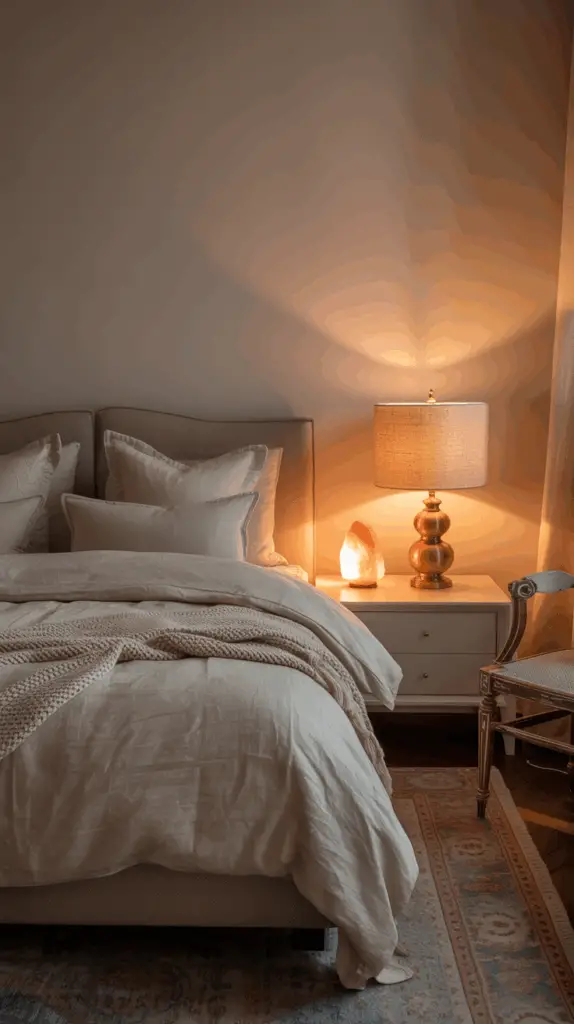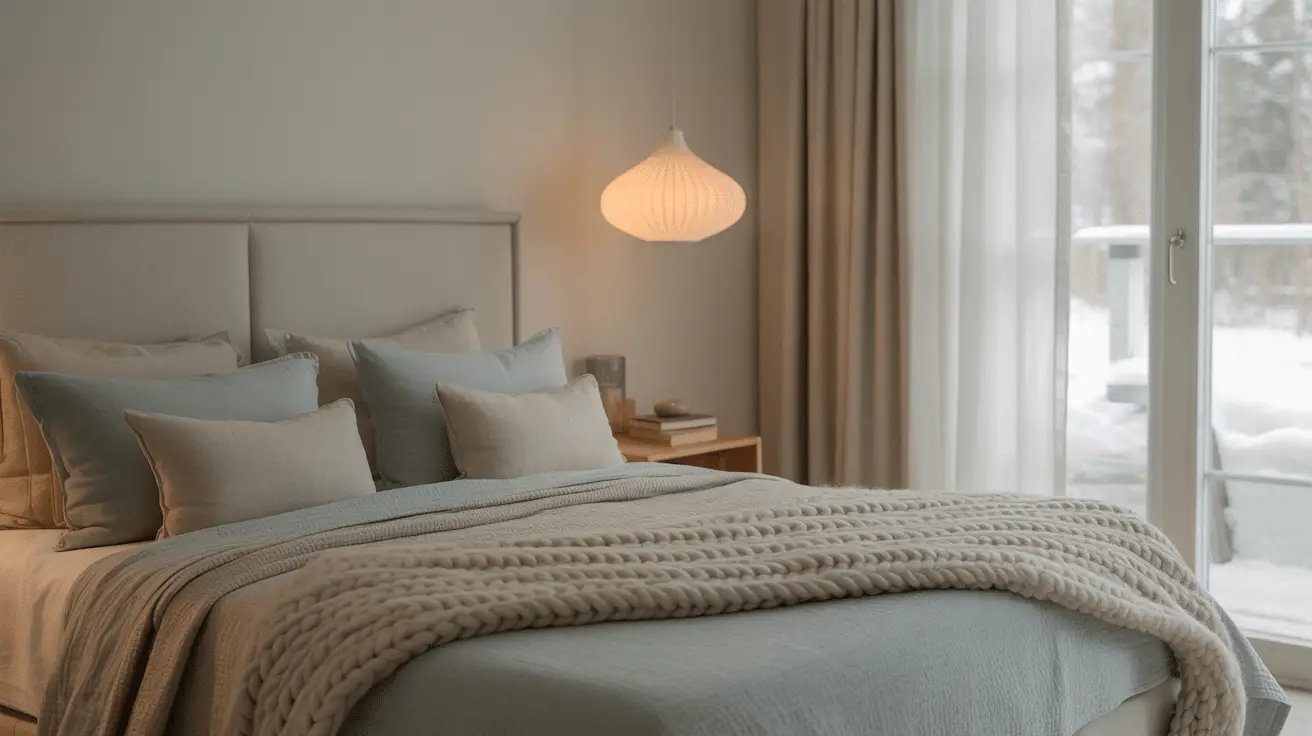Serene Master Bedroom Decor Ideas to Improve Sleep Quality Naturally
Table of Contents
A Sanctuary for Sleep: Why Your Bedroom Decor Matters More Than You Think
A good night’s sleep isn’t just about a plush mattress or blackout curtains—it’s deeply connected to the environment around you. Studies show that over 30% of adults experience poor sleep, and your bedroom design could be a silent culprit. Whether it’s overstimulating colors, cluttered spaces, or harsh lighting, subtle design choices can heavily influence your rest and recovery.
But what if your master bedroom could become more than just a place to crash? Imagine it as a tranquil retreat—tailored to quiet your mind, ease your body, and invite deep, uninterrupted sleep.
In this post, we’ll explore intentional and research-backed bedroom decor strategies designed to support better sleep. From calming color palettes to noise-reducing textures, natural materials, and lighting tips, every idea is crafted to bring more serenity into your space. We’ll also include visual breakdowns to help you reimagine your bedroom without the guesswork.
By the end, you’ll have all the tools you need to create a master bedroom that doesn’t just look serene—but feels like a dream.
Choose Calming Colors That Soothe the Senses
Color psychology plays a massive role in sleep quality. Certain hues trigger relaxation, while others stimulate the brain. If your bedroom walls scream red or neon green, they could be contributing to sleepless nights.
Opt for soft, nature-inspired shades like muted blues, sage green, soft grays, or warm beiges. These tones mimic the calm of water, sky, and earth—creating a visual softness that eases tension. Avoid high-saturation or overly contrasting colors, as they energize rather than relax.
Consider painting an accent wall in a subtle pastel blue or layering tones like oatmeal and ivory across your bedding. Stick to a monochromatic palette with soft contrasts—this keeps the visual energy low, encouraging calm.
Textures matter too. Linen, cotton, and wool in similar hues create tactile softness that pairs with your palette.
Layer Lighting for a Restful Ambience
Lighting isn’t just functional—it shapes how your space feels and impacts melatonin production. Bright overhead lighting late at night can trick your brain into staying alert, while warm, layered light encourages your circadian rhythm to wind down.
Start by reducing reliance on a central ceiling fixture. Instead, build a lighting “ecosystem” using bedside lamps, wall sconces, and even dimmable floor lights. Choose bulbs with a color temperature of 2700K or lower—these emit a soft, amber-like glow, perfect for winding down.
Task lighting should be kept low and indirect. Install dimmer switches to adjust brightness levels throughout the evening. Candles or salt lamps can also add a warm glow, ideal for a pre-sleep ritual.
| Lighting Layer | Purpose | Recommended Feature |
| Ambient | General room glow | Dimmable ceiling fixture, floor lamp |
| Task | Reading or journaling | Soft bedside lamp, directional sconce |
| Accent | Mood setting | Salt lamp, LED strip under bed |

Invest in Natural Materials and Organic Textures
Artificial fabrics and synthetic surfaces can disrupt not only your skin’s comfort but also the emotional experience of your space. Natural materials connect us to the earth, offering tactile grounding that’s essential for relaxation.
Opt for organic cotton or linen bedding—both breathable and naturally soft. Choose wooden bed frames, woven baskets, and wool throws to add warmth and earthy richness. These materials age beautifully, further reinforcing a sense of timeless calm.
Rugs made of jute, sisal, or wool help insulate noise and feel inviting underfoot. Even small additions—like a bamboo tray or a ceramic diffuser—can elevate the serenity of your space.
| Material | Best Use | Benefits |
| Linen | Bedding, curtains | Breathable, temperature regulating |
| Solid Wood | Furniture | Durable, grounding presence |
| Wool | Throws, rugs | Warm, noise-reducing |
| Rattan/Bamboo | Storage, decor accents | Light, textural contrast |

Declutter and Create Visual Breathing Room
A cluttered room equals a cluttered mind. Visual chaos can elevate cortisol levels and subconsciously remind you of undone tasks. To sleep better, your bedroom must be free of overstimulation—both physically and mentally.
Start with a purge: keep only essentials on nightstands, store seasonal clothing elsewhere, and remove items that don’t serve your rest. Use under-bed storage for extra bedding or out-of-season garments.
Consider concealed storage solutions, such as nightstands with drawers or woven baskets tucked into shelving units. Avoid open shelving unless it’s intentionally styled with minimal, cohesive objects.
Keep art simple and soothing—abstract pieces or calming landscapes work best. Mirrors should be placed thoughtfully to reflect light without causing distraction.
| Decluttering Focus | Strategy | Effect on Sleep |
| Nightstand | Only keep lamp, book, and diffuser | Reduces mental clutter |
| Closet | Rotate seasonally | Creates spaciousness |
| Surfaces | Minimal decorative items | Lowers visual stimulation |
Use Scent and Sound to Anchor a Sleep Routine
Sensory details complete the atmosphere. Scent and sound are powerful sleep anchors, helping the body associate the space with winding down.
Essential oils like lavender, chamomile, and sandalwood are scientifically shown to lower heart rate and anxiety levels. Use a ceramic diffuser or pillow spray to layer these calming aromas into your nightly routine.
Sound also plays a huge role. Instead of silence—which can highlight random nighttime noises—introduce gentle, consistent background audio like white noise, soft rainfall, or ocean waves. Consider a bedside sound machine or a small speaker paired with a sleep-friendly playlist.
Even better, automate both scent and sound. Smart diffusers and sleep timers can gently nudge you toward a consistent bedtime rhythm.
| Sense | Sleep Aid | Suggested Tools |
| Scent | Lavender, sandalwood | Diffuser, pillow spray |
| Sound | Ocean waves, white noise | Sleep sound machine, smart speaker |
Design a Bed That Invites Deep Rest
The bed is the centerpiece of any master bedroom—and it should reflect your intention to rest. Beyond just a good mattress, it’s about how you layer your sleep zone to promote physical and psychological relaxation.
Start with high-quality, breathable bedding. Layer textures like a light quilt, plush duvet, and a couple of soft throws. This allows temperature regulation and adds a sense of luxury. Stick to a maximum of two or three pillows per side—avoid overcrowding.
Headboards should be upholstered or softly framed to add warmth and eliminate hard visual lines. Neutral, muted colors promote a grounded energy. Your bed should always feel turned down and inviting by evening—not a chaotic mess.
| Element | Why It Matters | Ideal Choice |
| Mattress | Core comfort | Medium-firm, breathable |
| Bedding Layers | Thermoregulation & coziness | Linen or percale sheets, layered throws |
| Headboard | Aesthetic & warmth | Upholstered in soft fabric or light wood |
Incorporate Sleep-Supportive Decor Rituals
Routine is essential for sleep, and your decor can help cue these rituals naturally. Create a small pre-bed space for mindfulness—perhaps a corner chair with a reading light, or a calming tea setup with a small tray on your dresser.
Display only meaningful, calming decor. Crystals, minimal sculptures, a single scented candle—each piece should serve your intention of rest, not distraction.
Introduce tactile rituals: slip on cozy slippers, dim the lights with a switch by your bed, or keep a journal to release mental clutter. Let your decor support actions that signal it’s time to wind down.
| Ritual | Decor Support | Effect |
| Reading | Soft lamp + armchair | Wind-down habit |
| Tea | Tray with mugs + tin | Calming transition |
| Journaling | Notebook + pen holder | Mind-clearing practice |
Conclusion: A Bedroom That Breathes With You
Your master bedroom isn’t just a room—it’s the last place you see at night and the first space you meet each morning. Every design choice, from colors to clutter, lighting to linens, affects your body’s ability to rest, recover, and reset.
By crafting a space that feels serene—anchored in calming tones, natural textures, and sleep-friendly lighting—you’re setting yourself up for deeper, more restorative sleep. These changes don’t require a full renovation—just mindful edits with lasting impact.
Let your bedroom whisper peace, not scream distraction. Because better sleep begins with better space.

